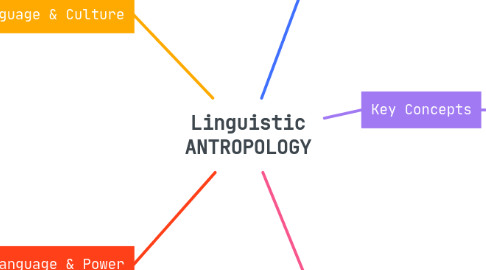
1. Language & Culture
1.1. Language Endangerment
1.1.1. The process by which languages become at risk of disappearing due to social, political, or cultural pressures.
1.2. Identity & Oral Traditions
1.2.1. The ways in which language is tied to group identity and how stories, histories, and traditions are passed down through speech.
2. Difinition and Scope
2.1. study of language in culture
2.1.1. Examines how language shapes and reflects cultural practices, traditions, and beliefs.
2.2. Human communication
2.2.1. Investigates how people use language to interact, express emotions, and share knowledge.
3. Key Concepts
3.1. Sapir-Whorf Hypothesis
3.1.1. The idea that the structure of a language influences the way its speakers think and perceive the world
3.2. Code-Switching
3.2.1. The practice of alternating between two or more languages or dialects in conversation, often based on social context.
3.3. Nonverbal Communication
3.3.1. The transmission of messages without words, including gestures, facial expressions, and body language
4. Language & Power
4.1. Linguistic Hegemony
4.1.1. The dominance of one language over others, often due to political, economic, or cultural influence (e.g., English as a global language).
4.2. Political Discourse
4.2.1. The use of language in politics to persuade, influence public opinion, or assert power
5. Research Methods
5.1. Ethnographic Fieldwork
5.1.1. A research method where anthropologists immerse themselves in communities to observe and document language use in real-life settings
5.2. Discourse Analysis
5.2.1. The study of spoken or written language in context, focusing on how meaning is constructed through communication.
